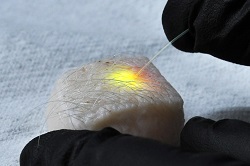Letting the light in: micro-lasers in the body point the way to better cell monitoring and future therapies
With lasers traditionally coming out of physics laboratories and typically being used for manufacturing and product solutions, from industrial robots to DVD players, it is perhaps unsurprising they are often regarded as engineering devices. Yet, this is highly misleading. A laser simply brings together three elements: an optical cavity, an external source of energy and gain material, which amplifies the light. Experimenting with these basic components greatly opens up possibilities for the creative production and use of lasers, as the EU-funded LIVINGLASER project has demonstrated. The introduction of bio-lasers LIVINGLASER set out to build on previous work which had integrated lasers into biological systems. By doing so, lasers can function as sensors, enabling a better understanding of cellular processes especially when combined with fluorescent dyes. An added benefit is that collocation within cells and tissues allows long term measurement and tracking of organisms for improved diagnostics. Additionally, actually creating lasers from biocompatible, biodegradable and even live materials helps simplify implantation into organisms. The project team demonstrated the operation of a laser inside a live human cell. The laser was ten times smaller than the diameter of a human hair and made out of solid polystyrene beads. As project coordinator Dr. Matjaz Humar explains, ‘The beads contained a fluorescent dye with the surface of the bead confining light to the inside of the sphere, so creating the necessary optical cavity. We fed these laser beads to live cells in culture, which engulfed the lasers within a few hours. After that, we operated the lasers by illuminating them with external light, without harming the cells’. As the bead lasers within each cell emit light slightly differently, they offer a unique marker which can be easily detected and used for cell tagging and as very sensitive sensor. Dr. Humar elaborates, ‘We measured the change in the refractive index which is directly related to the concentration of chemical constituents within the cells, such as DNA, proteins and lipids. He goes on to claim that, ‘With careful laser design, up to a trillion cells could be uniquely tagged. That is every single cell in the human body.’ As an alternative, the team also used a micro pipette to inject a droplet of oil, containing fluorescent dyes, to function as a laser inside cells. The cell deformed the droplet and cellular forces caused by processes such as division and migration, were tracked and measured very precisely by analysing the light emitted. Taking the concept of a bio-laser further the team achieved, somewhat to their surprise, lasing inside fat cells. As Dr. Humar again explains, ‘Fat cells already contain lipid droplets that can work as cavities creating natural lasers. That means each of us already has millions of lasers inside our fat tissue that are just waiting to be activated to produce laser light.’ Additionally, to extend the project’s co-opting of natural forces, instead of adding dye to the fat cells, the team was able to experiment with cells which produce green fluorescent proteins and used bioluminescence, a natural source of light. Gearing up for a range of diagnostic and therapeutic options LIVINGLASER’s options to implant, inject or adopt naturally occurring lasers, within various tissues, offers a range of therapeutic options. Eventually they could offer remote sensing of the inside of the human body, avoiding the need for tissue samples. They could also be used for targeted drug delivery, with lasers activating photosensitive drugs and so killing microbes or cancerous cells. Additionally, the tagging of individual cells will facilitate the study of cell migration including cancer metastasis. To help support the technology LIVINGLASER has developed super-resolution microscopy, particularly useful for deep imaging of biological tissues. The team have also developed bio-derived or biocompatible, and biodegradable optical fibres, which can be used to pump these lasers deep within the human body. As a proof of concept, photochemical tissue bonding for wound closure has already been developed, that may lead to faster healing and less scarring.







